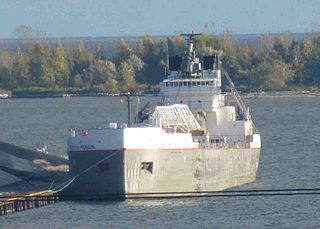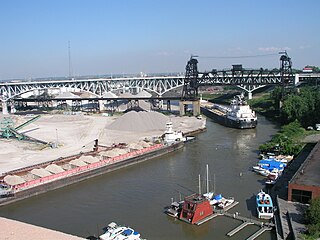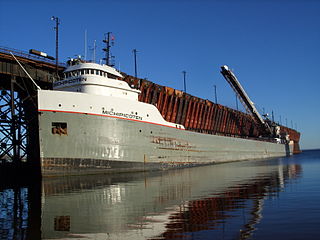
Lake freighters, or lakers, are bulk carrier vessels that operate on the Great Lakes of North America. These vessels are traditionally called boats, although classified as ships.
Port Weller Dry Docks was a shipbuilder on the Welland Canal at the Lake Ontario entrance. The shipbuilder was founded in 1946 and the site was initially owned by the Government of Canada for storage purchases. The shipyard expanded to include ship repair, and reconstruction work. In 1956, the drydock was sold to the Upper Lakes Shipping Company, which began the construction of vessels at the site. The shipyard twice went insolvent, most recently in 2015. Port Weller Dry Docks was used to build, refit and repair cargo vessels.
Quebecois was a lake freighter that served the Great Lakes, operating between ports in the United States and Canada. The vessel was launched in 1962 by Canadian Vickers Ltd of Montreal, Quebec, Canada. Used to carry grain and ore, Quebecois was built to the maximum dimensions allowed on the Saint Lawrence Seaway. The vessel entered service in 1963 and in 2012, the ship's named was altered to Algoma Quebecois. The ship was broken up for scrap at Port Colborne, Ontario, Canada in 2013.

MV Algocape was a Canadian lake freighter operated by Algoma Central Corp. Initially constructed for Canada Steamship Lines as Richelieu, the ship was sold to Algoma Central Corp in 2004 and renamed Algocape. In 2012, the ship was sold again to Dido Steel Corporation and renamed Goc and broken up for scrap.

Montrealais was a lake freighter launched in 1961. Constructed in two parts, the vessel was completed in 1962 and registered in Canada. Utilized as a bulk carrier, the vessel served on the Great Lakes until 2015. Montrealais was sold three times between 1962 and 2012, when the freighter was acquired by Algoma Central Corp. and renamed Algoma Montrealais. The bulk carrier continued in service until 2015, when the vessel was renamed Mont and sold for scrap. Mont was taken to Aliağa, Turkey and broken up beginning on 10 July 2015.

Algoma Mariner is a Canadian lake freighter delivered to Algoma Central on 31 May 2011. The bulk carrier was the first new Canadian-flagged vessel on the Great Lakes in 25 years. Algoma Mariner is a Seawaymax vessel, designed to carry dry bulk through the Saint Lawrence Seaway and Great Lakes. The vessel was constructed at the Chengxi Shipyard in China and is currently in service.

MV Algonorth was a Seawaymax lake freighter built in 1970 and completed in 1971 by the Govan Division of Upper Clyde Shipbuilders Ltd. in Govan, Scotland as the bulk carrier Temple Bar. Her original owners were Lambert Bros. Shipping Ltd., of London, United Kingdom, sold the vessel in 1976 to Nipigon Transport Ltd., who had her hull lengthened and installed a new power plant for Great Lakes service. Re-entering service as Lake Nipigon, the ship was renamed Laketon in 1984 before returning to the name Lake Nipigon in 1986. In 1987, the lake freighter was sold to Algoma Central Railway which gave the ship its final named, Algonorth. In 2007, the ship collided with a dock in Toledo, Ohio. The ship was scrapped in 2012.

Sauniere was a self-unloading bulk carrier operated by Algoma Central. Laid down as Bulknes, before launching the vessel's name was changed to Brooknes. The ship was constructed and completed in 1970. The ship was initially owned by the Swedish company Kristian Jebsens Rederi A/S. In 1974, Algoma Central purchased the vessel, registered the ship in West Germany and renamed it Algosea. Algoma Central sent the ship to Swan Hunter in England to be lengthened. Emerging in 1976, Algosea sailed for Canada for conversion to a self-unloading bulk carrier at Herb Fraser and Associates in Port Colborne, Ontario. Algosea, which transported road salt between ports in the Gulf of St. Lawrence, Saint Lawrence Seaway and Great Lakes suffered three collisions and two groundings during its career. The Algosea was renamed Sauniere in 1982 and continued in service until 2009 when the bulk carrier was sold for scrap and broken up in Turkey in 2010.

Algorail was a lake freighter owned and operated by Algoma Central. The ship was built by Collingwood Shipyards in Collingwood, Ontario and was launched in 1967. The ship sailed on the North American Great Lakes and the Saint Lawrence Seaway delivering coal/coke, aggregates, slag, iron ore/oxides, salt, fertilizers, grain products, gypsum, quartzite, or sand. The ship was laid up in 2016 and sold for scrap in 2018.

John B. Aird was a self-discharging lake freighter/bulk carrier that was launched in 1983 and served on the Great Lakes and Saint Lawrence Seaway until 2017. The vessel was owned and operated by Algoma Central during that time, which had named the vessel for a former chairman of the Algoma Central Railway. Prior to the construction of Algoma Equinox in 2013, John B. Aird was the last vessel built for the company.

Algolake was a self-unloading bulk carrier owned and operated by Algoma Central. The ship entered service in 1977 on the Saint Lawrence Seaway. In 1994, the ship ran aground in the St. Lawrence River off Quebec. The ship was laid up for scrapping in 2018, renamed Gola and was later scrapped in Aliağa, Turkey.

The Robert S. Pierson is a bulk carrier built for and operated on the North American Great Lakes.

Algoma Progress was a self-unloading lake freighter and bulk carrier operating on the North American Great Lakes, owned by Algoma Central. Launched in 1968, the ship was originally named Canadian Progress and operated by the Upper Lakes Shipping. At launch, the ship was the largest self-unloading vessel on the Great Lakes. Canadian Progress was used to transport coal, iron ore, barley and road salt on the Great Lakes and Saint Lawrence Seaway. Canadian Progress ran aground twice, the first in 1985 and then again in 1988. In 2011, Upper Lakes Shipping sold its entire fleet to Algoma Central, which renamed the vessel Algoma Progress. In 2014, Algoma Progress was sold for scrap and broken up at Port Colborne, Ontario.
Algoma Navigator was a Canadian bulk carrier operated by Algoma Central. Like other bulk carriers, her potential cargoes included: coal/coke, aggregates, slag, iron ore/oxides, salt, fertilizers, grain products, gypsum, quartzite, or sand. The vessel was constructed by John Readhead & Sons in the United Kingdom in 1967 for the Cambay Steamship Company and launched as Demeterton. The vessel was enlarged in 1967 and sold in 1975 to the Upper Lakes Group which renamed the ship St. Lawrence Navigator. In 1979, the vessel was renamed Canadian Navigator after a rebuild. In 2011, the ship was sold to Algoma and became Algoma Navigator. In 2016, the bulk carrier was renamed Navi before being sold for scrap and broken up in 2016.

Algoma Buffalo, formerly Buffalo, is a diesel-powered lake freighter acquired by Algoma Central Corporation in 2018. This vessel was built in 1978 by Bay Shipbuilding Company at their yard in Sturgeon Bay, Wisconsin for the American Steamship Company and included self-unloading technology. The ship is 634 feet 10 inches (193.50 m) long and 68 feet (21 m) wide, with a carrying capacity of 24,457 tons deadweight (DWT), and is primarily used to ship road salt and construction goods. The vessel is currently in service.

Algosteel was a bulk carrier owned and operated by Algoma Central. The vessel was constructed in 1966 by Davie Shipbuilding at their yard in Lauzon, Quebec for Canada Steamship Lines and launched as A.S. Glossbrenner. In 1968, the vessel was acquired by the Labrador Steamship Company. In 1971, the ship was sold to Algoma Central. The vessel's name was changed to Algogulf in 1987 and to Algosteel in 1990. The bulk carrier primarily transported iron ore and grain along the Saint Lawrence Seaway and the Great Lakes. The vessel was taken out of service in April 2018 pending disposal and was scrapped in Aliağa, Turkey, in 2018 under the name Oste.
Algogulf was the third and last name of a bulk carrier launched in 1961, laid-up in 1999, and scrapped in 2002. The ship began her career in 1961 as J.N. McWatters, the second vessel of that name operated by the Misener Shipping Company. The bulk carrier was used to transport primarily grain and iron ore in the Saint Lawrence Seaway and Great Lakes. In 1991, the vessel was renamed Scott Misener by the company, the fourth of that name. In 1994, the ship was acquired by Algoma Central and renamed Algogulf, the second vessel of the name. The ship was laid up in 1999 and sold for scrapping in 2002.

Algoma Provider was a Canadian lake freighter, which operated from 1963 to 2013 under the flag of several shipping lines. She was built to seawaymax dimensions at the Collingwood Shipyards in Collingwood, Ontario for Canada Steamship Lines. She was powered by a steam turbine, and was the company's last steam-powered vessel. Initially named Murray Bay, the ship was sold in 1994 to Upper Lakes Shipping, which renamed the vessel Canadian Provider. In 2011, Upper Lakes Shipping sold its entire fleet to Algoma Central, which renamed the lake freighter Algoma Provider. The vessel continued in service until 2013, when she was sold to be broken up for scrap. The ship was renamed Ovi for her journey to the scrapyard in Turkey. During her career, the ship carried bulk cargoes to destinations along the Saint Lawrence Seaway and Great Lakes.

Michipicoten is a self-discharging lake freighter owned and operated by Canadian shipping firm Lower Lakes Towing. Michipicoten primarily hauls taconite from Marquette, Michigan, to the Algoma Steel Mill in Sault Ste. Marie, Ontario. It has a capacity of 22,300 tons, a speed of 12 knots (14 mph), and a length of 689 feet 6 inches (210.2 m).

Algosoo was a lake freighter constructed for Algoma Central in 1974 by Collingwood Shipyard in Collingwood, Ontario. The second ship of the name, Algosoo was the last lake freighter built in the traditional design for use on the North American Great Lakes, where the bridge topped a superstructure right in the ship's bow, and a second superstructure topped her engines, right in the stern. The vessel was used to transport bulk cargoes between ports on the Great Lakes. In 1986, the ship suffered a serious fire and 1994, was forced to run aground. Algosoo transported her last cargo in late 2015 and was sailed to the breaking yard at Port Colborne, Ontario in October 2016.
















